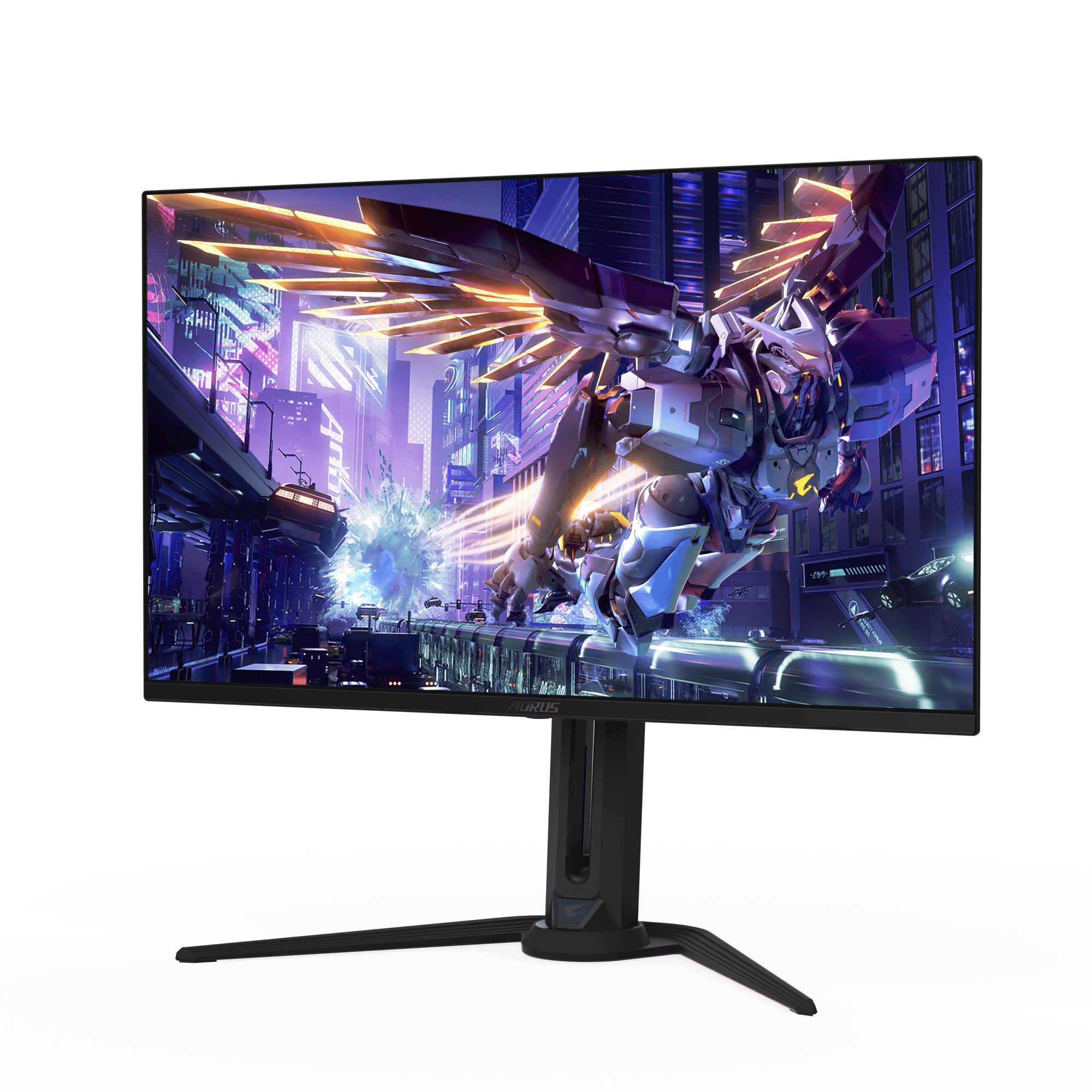Choosing the right monitor for photo editing in 2025 goes beyond resolution—it’s about ensuring the colors you see on screen are the colors you get in print or online. With ever-improving panel technology, wider color gamuts, and more precise calibration tools, today’s displays are more powerful and accurate than ever. Whether you’re working with RAW files, printing gallery-quality images, or just editing for Instagram, the monitor you use plays a critical role.
One of the biggest shifts in 2025 is the increasing availability of professional-grade OLED panels—offering incredible contrast ratios and vibrant colors—though many creatives still prefer IPS for its long-term stability and minimal risk of burn-in. Below is a refreshed, expert-backed list of the best monitors you can buy this year for photo editing, with options across price points and use cases.
🔥 Top Pick: Gigabyte AORUS FO32U2P (New in 2025)
- Screen Size: 32 inches
- Resolution: 3840×2160 (4K UHD)
- Panel Type: QD-OLED
- Color Gamut: 100% AdobeRGB, 100% DCI-P3
- Price Range: ~$1,300
Why It’s Great:
The FO32U2P represents the cutting edge in OLED photo editing. It offers a wide color gamut with true 10-bit color depth, DisplayHDR True Black 400 certification, and factory calibration. It also includes DisplayPort 2.1 and USB-C with 65W charging. If you’re willing to manage potential burn-in with care (like using auto-dimming and screen shift), this monitor delivers unmatched vibrancy and clarity.
Pros:
- Ultra-deep blacks and high contrast
- Massive color gamut coverage
- Perfect for hybrid photo/video work
Cons:
- Risk of image retention over time
- Price is premium for OLED tech
🥇 Eizo ColorEdge CS2741
- Screen Size: 27 inches
- Resolution: 2560×1440 (QHD)
- Panel Type: IPS
- Color Gamut: 99% AdobeRGB
- Price Range: ~$1,200
Why It’s Great:
Eizo continues to be the benchmark in color-critical displays. The CS2741 includes hardware-level calibration via Eizo’s ColorNavigator software, brightness uniformity correction, and a wide viewing angle. While it doesn’t offer 4K, the QHD resolution is still sharp at 27 inches and ideal for print workflows.
Pros:
- Best-in-class color accuracy
- 16-bit LUT support
- Long lifespan with minimal color drift
Cons:
- No 4K resolution
- Expensive compared to similarly sized monitors
💼 Dell UltraSharp U3224KB (6K Thunderbolt Monitor)
- Screen Size: 32 inches
- Resolution: 6144×3456 (6K)
- Panel Type: IPS (IPS Black)
- Color Gamut: 100% sRGB, 99% DCI-P3
- Price Range: ~$2,400
Why It’s Great:
This is a dream setup for professionals handling large-format photos or working on multi-layered compositions. The extra pixel density of 6K makes even the smallest details pop. It also doubles as a productivity hub with Thunderbolt 4, RJ45 Ethernet, and multiple USB-C ports.
Pros:
- Incredible resolution
- Studio-quality webcam and speaker system
- Excellent connectivity and build
Cons:
- Overkill for casual users
- Cost may outweigh benefit unless you need 6K
🧪 ASUS ProArt PA32UCR-K
- Screen Size: 32 inches
- Resolution: 3840×2160 (4K UHD)
- Panel Type: IPS
- Color Gamut: 99% AdobeRGB, 99% DCI-P3
- Price Range: ~$1,300
Why It’s Great:
ASUS’s ProArt line is tailored for creatives. The PA32UCR-K is color-validated out of the box and supports HDR10 and Dolby Vision. It offers true 10-bit color and 1000-nit brightness, making it ideal for working in both photo and HDR video.
Pros:
- Extremely versatile with HDR and SDR
- Hardware calibration support
- Excellent connectivity options
Cons:
- Requires calibration to reach full potential
- Some edge-lit dimming artifacts
🥈 BenQ SW272Q
- Screen Size: 27 inches
- Resolution: 2560×1440 (QHD)
- Panel Type: IPS
- Color Gamut: 99% AdobeRGB, 100% sRGB
- Price Range: ~$800
Why It’s Great:
For under $1,000, the SW272Q remains a smart choice for photographers who want AdobeRGB coverage, a shading hood, and hardware calibration. It’s great for those primarily working with print and photo books rather than large 4K files.
Pros:
- Color-accurate out of the box
- Hotkey puck and USB-C support
- Factory calibrated and Pantone Validated
Cons:
- Not 4K
- No HDR support
🥉 Apple Studio Display (5K Retina)
- Screen Size: 27 inches
- Resolution: 5120×2880 (5K Retina)
- Panel Type: IPS
- Color Gamut: P3 wide color
- Price Range: ~$1,599
Why It’s Great:
Perfect for macOS users, especially those using Final Cut Pro or Adobe Lightroom. The 5K resolution and macOS integration make color consistency and scaling a non-issue. Its anti-reflective coating and high brightness help in well-lit studios.
Pros:
- Brilliant clarity with Retina scaling
- macOS-calibrated display pipeline
- Great built-in speakers and webcam
Cons:
- No native AdobeRGB support
- No hardware calibration support
💡 Budget Pick: LG 27UN850-W
- Screen Size: 27 inches
- Resolution: 3840×2160 (4K UHD)
- Panel Type: IPS
- Color Gamut: 99% sRGB
- Price Range: ~$400
Why It’s Great:
If you’re looking for a capable 4K monitor for light editing or hobby-level work, the LG 27UN850-W is hard to beat. It offers USB-C, HDR support, and great pixel density, though it lacks the wide color gamut professionals may need.
Pros:
- Affordable 4K IPS
- Modern design and solid build
- USB-C with 60W charging
Cons:
- No AdobeRGB or hardware calibration
- Lower contrast and brightness
Key Specs To Prioritize for Photo Editing Monitors
- Color Gamut: Look for 99-100% AdobeRGB or DCI-P3 if you’re working in print or cinema color spaces. sRGB-only monitors are okay for web-only editing.
- Hardware Calibration: Monitors that support internal LUT adjustments (with devices like X-Rite i1Display or Datacolor Spyder) offer greater color precision.
- Panel Type: IPS and OLED are your best bets. IPS for stability and color consistency, OLED for contrast and dynamic range—though with careful management.
- Connectivity: USB-C, DisplayPort, and Thunderbolt 4 are important for clean desk setups and fast data transfer, especially if you’re using high-end laptops or cameras.
Key Takeaways
- Choose monitors with at least 27 inches and 4K resolution for optimal photo editing results.
- Look for wide color gamut coverage and hardware calibration features when selecting professional editing displays.
- Consider factors like color accuracy (Delta E <1.5) and HDR capability for the most realistic representation of your images.
Essential Features and Specifications for Photo Editing Monitors
Choosing the right monitor for photo editing requires understanding several key technical specifications that directly impact image quality and workflow efficiency. A high-quality photo editing display needs to deliver accurate colors, sufficient resolution, and consistent performance.
Understanding Color Spaces and Accuracy
Color accuracy is the cornerstone of photo editing monitors. Professional displays should support wide color gamuts including sRGB, Adobe RGB, and DCI-P3. The Adobe RGB color space is particularly important as it covers a broader range of colors than standard sRGB.
A quality photo editing monitor should cover at least 95% of Adobe RGB and 99% of sRGB color spaces. The higher the coverage percentage, the more accurate the color reproduction will be in your editing work.
Color accuracy is measured by Delta E values, with lower numbers indicating better accuracy. Look for monitors advertising Delta E ≤ 1.5, which means color differences are imperceptible to the human eye.
Many high-end monitors come factory calibrated, saving time and ensuring accuracy right out of the box. Models featuring hardware calibration with 16-bit 3D LUTs provide superior color precision compared to software-only solutions.
Importance of Monitor Resolution and Size
Resolution directly affects how much detail you can see in your photos. For professional photo editing, 4K resolution (3840 x 2160) has become the standard, offering crisp detail for precise adjustments.
Monitor size should balance with resolution to maintain optimal pixel density (PPI). A 27-32 inch monitor with 4K resolution provides an ideal balance between workspace and sharpness.
For budget constraints, a high-quality 1440p (2560 x 1440) display can serve as a good alternative while still offering reasonable detail for editing tasks.
Curved monitors may benefit ultrawide setups, but flat panels typically provide more consistent viewing angles and less distortion for color-critical work.
Consider screen real estate needed for your workflow – photographers often benefit from larger screens that allow viewing images at 100% while keeping tools visible.
Calibration and Color Consistency
Regular calibration is essential for maintaining color accuracy over time. Hardware calibration options allow the monitor to store color profiles in its internal hardware rather than relying on graphics card adjustments.
Programs like Palette Master Element or other proprietary software from manufacturers help maintain screen-wide color accuracy through the monitor’s lifespan.
Brightness uniformity matters significantly for photo editing. Look for monitors with certification for brightness and color uniformity across the entire screen surface.
High-quality IPS panels provide better viewing angles and more consistent colors from edge to edge compared to VA or TN technologies.
Consider brightness specifications – aim for at least 300-350 nits for standard editing, or higher (400+ nits) if you work with HDR content. USB Type-C connectivity can simplify your workspace by reducing cable clutter and providing power delivery to laptops.
Choosing the Right Monitor for Professional Photo Editing
Selecting the right monitor for photo editing requires careful consideration of color accuracy, resolution, and panel technology. Professional photographers need displays that show true-to-life colors and fine details.
Top Monitors for Different Editing Needs
Dell UltraSharp U3224KB stands out for professional photo editing with its impressive 32-inch display and 6K resolution. This monitor delivers exceptional detail and color accuracy essential for precise editing work.
EIZO monitors, particularly the ColorEdge series, are industry standards for photography professionals. They feature built-in calibration tools and wide color gamut coverage that ensures consistent color reproduction.
For those on a tighter budget, BenQ’s SW series monitors offer excellent color accuracy and essential features for photo editing without the premium price tag.
OLED monitors are gaining popularity for their perfect blacks and superior contrast ratios. They’re ideal for photographers who work with high-contrast images or in darker environments.
Apple’s Studio Display provides excellent color accuracy and seamless integration with Mac devices, making it perfect for photographers in the Apple ecosystem.
Integration with Editing Software and Workflow
Modern photo editing monitors offer features that integrate directly with popular software. Some displays include modes specifically calibrated for Adobe Photoshop and Lightroom Classic.
Paper Color Sync technology in certain monitors simulates how images will appear when printed. This feature is invaluable for photographers who regularly print their work.
High-end monitors often include software that saves color profiles for different editing applications. This allows photographers to switch between color spaces depending on their current project.
IPS panels remain popular for photo editing due to their consistent color reproduction and wide viewing angles. They maintain color accuracy even when viewed from different positions.
Compatibility with Professional Equipment and Systems
When choosing a monitor, consider compatibility with both hardware and software. Most professional displays work with both Windows machines and Mac devices, but connectivity options vary.
Some monitors include USB-C connections with power delivery. This allows photographers to connect and charge laptops with a single cable, streamlining the workspace.
Monitor calibration devices are essential companions for serious photo editing. High-end monitors from EIZO often include built-in calibration tools, while others require external devices.
For professional photographers working with 4K or higher resolution content, ensure your computer has adequate graphics capabilities. The best monitor will underperform if paired with insufficient hardware.
Photographers who collaborate with clients benefit from monitors with consistent color profiles. This ensures that what clients see matches what the photographer intended.
Frequently Asked Questions
Selecting the right monitor for photo editing involves understanding key specifications that impact image quality and workflow efficiency. The following questions address common concerns when investing in a photo editing display.
Which monitor specifications are most crucial for professional photo editing?
For professional photo editing, color accuracy is the most essential specification. A monitor should cover at least 95% of the Adobe RGB color space for professional work. Color depth is also vital, with 10-bit panels displaying over a billion colors compared to 8-bit panels.
Resolution greatly impacts detail visibility, with 4K (3840 x 2160) now considered standard for serious work. Panel uniformity ensures consistent brightness and color across the entire screen.
Calibration features are crucial as they allow photographers to maintain color accuracy over time. Many professional monitors include hardware calibration options and built-in colorimeters.
How important is color accuracy in a budget monitor for photo editing purposes?
Color accuracy remains important even in budget monitors for photo editing. While premium displays offer better performance, many affordable options now provide decent color reproduction with 100% sRGB coverage, which is suitable for hobbyists and beginners.
Budget-conscious editors should look for monitors with factory calibration reports. Models from BenQ and ASUS often offer good color accuracy at lower price points.
A budget monitor with good color accuracy will produce more predictable results when prints are made. This prevents the frustration of seeing significant differences between screen images and physical prints.
In terms of resolution, should one prioritize a 4K monitor for photo editing over lower resolutions?
4K resolution provides significant advantages for photo editing by showing finer details and more accurate representation of high-resolution images. This is particularly beneficial when working with today’s high-megapixel cameras.
However, for smaller screen sizes (24 inches or less), the benefits of 4K may be less noticeable. A quality 1440p (QHD) monitor can be sufficient for many photographers while being more affordable.
Screen size should be considered alongside resolution. The Dell UltraSharp U3224KB with its 32-inch 6K display represents the high end, while a 27-inch 4K monitor often provides the best balance of detail and usability.
What distinguishes a monitor suitable for both photo editing and gaming?
A dual-purpose monitor for both photo editing and gaming needs to balance color accuracy with fast response times. IPS panels typically offer this middle ground with good color reproduction and acceptable gaming performance.
Refresh rates of at least 120Hz are preferred for gaming, while photo editing benefits from higher resolution. Many monitors now offer specialized modes that can switch between color-accurate settings and gaming-optimized profiles.
Connectivity is another important factor. Multiple ports allow connecting to different devices without reconfiguring cables each time.
Can you recommend some of the best budget monitors for photo editing available on the market?
The BenQ PD2705Q offers excellent color accuracy at a moderate price point. It features 100% sRGB coverage and factory calibration, making it suitable for beginners and intermediate photographers.
ASUS ProArt displays provide good value with professional features like hardware calibration support. The PA278QV model offers 100% sRGB coverage and 75Hz refresh rate at a competitive price.
The Dell S2722QC combines 4K resolution with USB-C connectivity in a budget-friendly package. It delivers good color performance for everyday editing tasks without breaking the bank.
What panel technology is typically preferred for high-quality photo editing and why?
IPS (In-Plane Switching) panels are widely preferred for photo editing due to their superior color accuracy and wide viewing angles. These panels maintain consistent colors even when viewed from different positions.
Mini-LED technology is emerging as a premium option, offering improved contrast ratios closer to OLED while avoiding burn-in issues. The Gigabyte AORUS FO32U2P uses this technology to deliver excellent results.
OLED panels provide perfect black levels and infinite contrast ratios but come with a burn-in risk. They’re becoming more popular for high-end photo editing as manufacturers implement features to minimize burn-in concerns.






